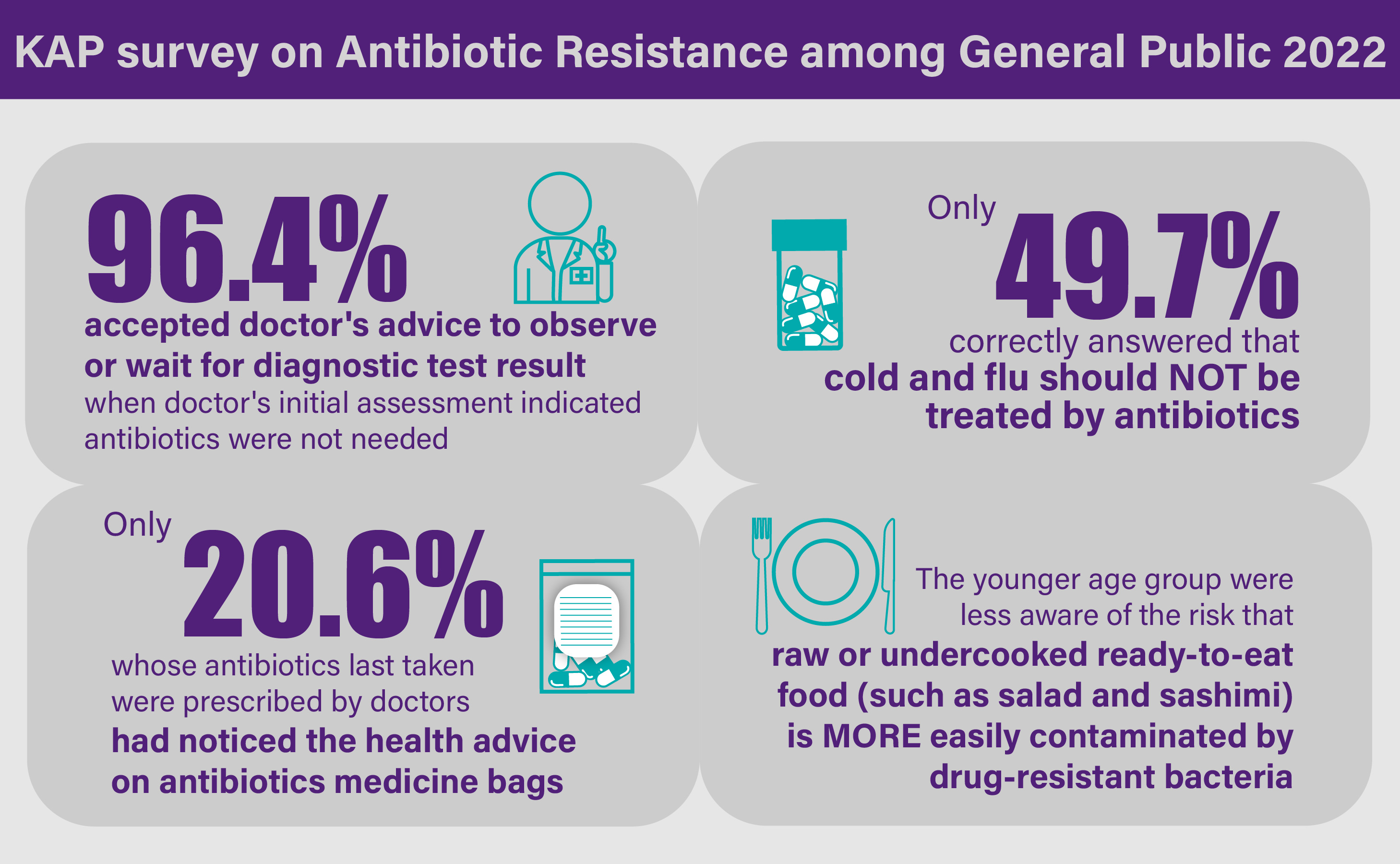General Public's Knowledge, Attitude and Practice Survey on Antibiotic Resistance 2022
Release date: 13 April 2023
General Public's Knowledge, Attitude and Practice Survey on Antibiotic Resistance 2022

Introduction
The Centre for Health Protection (CHP) commissioned the Hong Kong Institute of Asia-Pacific Studies, Chinese University of Hong Kong, to conduct this territory-wide in order to explore the knowledge, attitude and practice of the general public with respect to antibiotics and their awareness of antibiotic resistance.
Research Methodology
The target population of this telephone survey was non-institutional Hong Kong residents aged 15 or above who could speak Cantonese, Putonghua or English (excluding foreign domestic helpers). By means of landline and mobile telephone interviews via random sampling, the survey was conducted from 7 September 2022 to 6 October 2022. The sample size of 1,076 successful interviews (493 from landline numbers and 583 from mobile numbers) was achieved with a combined response rate of 32.7%.
Key Findings
- Among those respondents who had ever taken antibiotics, a vast majority of them (95.4%) reported their last taken antibiotics were prescribed by doctors.
- Among respondents (21.6% of all respondents) who reported that they had consulted a doctor (for cold or flu) in the past 12 months, majority (97.2%) did not request antibiotics during that consultation.
- When a doctor’s initial assessment indicated that antibiotics are not needed, the vast majority of respondents (96.4%) would accept the doctor’s advice to observe for a few more days or to wait for the diagnostic test result before deciding whether to prescribe antibiotics or not.
- The majority of respondents (66.3%) wished their doctor to share decision making on antibiotics prescription with them.
- Among those last taken antibiotics prescribed by doctors, only 20.6% reported that they had noticed the health advice (e.g. disinfect and cover all wounds) on antibiotic medicine bag.
- A large proportion of respondents have heard of the respective terms of superbugs (超級細菌) (81.4%), and antibiotic resistance (抗生素耐藥性) (76.0%) in either Chinese or English.
- Less than half of all respondents (49.7%) correctly answered that cold and flu should not be treated by antibiotics.
- A large proportion of respondents correctly understood the severity of AMR: Many infections are becoming increasingly resistant to treatment by antibiotics (81.2%); if bacteria were resistant to antibiotics, it could be very difficult or impossible to be treated (71.4%).
- Nevertheless, less than half of respondents correctly answered that bacteria which were resistant to antibiotics could be spread from person to person (44.1%).
- A substantial proportion of respondents (35.8%) considered not much they could do to stop antibiotic resistance.
- This survey revealed that the group aged 65 and above generally having the lowest level of knowledge about AMR and correct use of antibiotics among all age groups.
- The youngest age group of 15 to 24 was found least likely to agree that raw or undercooked ready-to-eat food (such as salad and sashimi) was more easily to be contaminated by drug- resistant bacteria.
Recommendations
- More health education on which kinds of common health conditions could be treated with antibiotics should be provided to the public.
- Only less than half of the respondents knew that bacteria resistant to antibiotics could be spread from person to person. Public education on knowledge on AMR and related infection control practices should be enhanced.
- The survey revealed that vast majority of the public would accept their decision when initial assessment indicate that antibiotics are not necessary. Hence, doctors should consider involving patients when discussing treatment regime on infections and to ensure appropriate and correct use of antibiotics when deemed necessary.
- Health promotion activities could be considered with better design of the health advice printed on antibiotics medicine bags, in addition to explanation on the health advices by pharmacists while dispensing antibiotics to patients.
- Tailor-made health messages and promotion that could be easily accessible to and understandable by the elders should be enhanced.
- In order to reach and draw the attention of young people to risk of raw or undercooked ready-to-eat food, better design of health education materials to promote food safety should be attractive to them, and to be disseminated through channels that young people commonly use like social media.
The survey report can be accessed here.